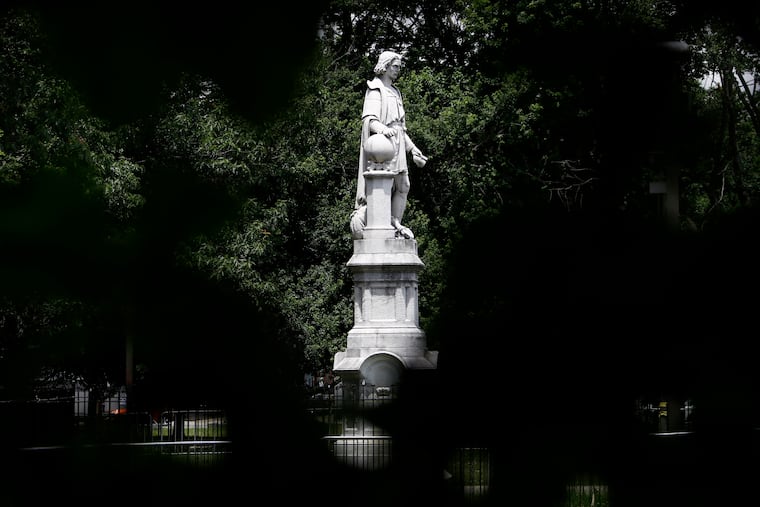Let’s reimagine Marconi Plaza as a monument to Native and Black Americans | Opinion
Why not tell the full story of the ancestral land of the Lenape Nation of Pennsylvania, on which the Columbus statue sits, and the layered histories of Marconi Plaza?

This summer, one issue seemed to capture the city’s attention: What should we do about the statue of Columbus at Marconi Plaza? No one can deny the important role Christopher Columbus played in history, but to many, he is a reminder of slavery and genocide.
The movement to remove Christopher Columbus statues gained momentum in the wake of Black Lives Matter protests, which Indigenous people joined in 2020. At least 40 monuments to Columbus have been removed since 2018, the majority of which were taken down in 2020 and 2021. Approximately 130 memorials are still standing, including two in Philadelphia (Marconi Plaza and Penn’s Landing).
Rather than remove the Columbus statue in Marconi Plaza, George Bochetto, attorney for Friends of Marconi Plaza, recently suggested erecting an additional statue to honor Indigenous People. “You let everybody celebrate their ethnicity,” he said. My response: Why not? Why not tell the full story of the ancestral land of the Lenape Nation of Pennsylvania, on which the Columbus statue sits, and the layered histories of Marconi Plaza?
» READ MORE: Should the Columbus statue leave Marconi Plaza? | Pro/Con
A site of resistance
Native Americans and African Americans have a shared history of resistance to slavery and white supremacy. Indigenous people and African Americans are descendants of people whose land was stolen and people who were stolen from their homeland. Formerly enslaved people lived alongside Indigenous people in maroon communities in Louisiana and other Southern states. (Although some tribes enslaved Black people, I and other historians believe this form of slavery was much less brutal than American chattel slavery.)
They also share ancestors. Notables of mixed Native American and African American ancestry include George H. White, the first “Black Indian” member of Congress, and NBA All-Star Kyrie Irving.
“Why not tell the full story of the ancestral land of the Lenape Nation of Pennsylvania, on which the Columbus statue sits, and the layered histories of Marconi Plaza?”
November is Native American Heritage Month, so a good time to remind everyone of their contributions to the American story, which were erased by the false narrative that Christopher Columbus “discovered” land on which Indigenous people have lived for thousands of years. When Columbus and other European settlers came, Native Americans didn’t want to give up their land, so these public memorials to Columbus are actually sites of resistance.
Additionally, Marconi Plaza was the site of the celebration to commemorate the 50th anniversary of the Emancipation Proclamation signed by President Abraham Lincoln on Jan. 1, 1863. The Philadelphia commemoration was organized by Harry W. Bass, the first African American state legislator in Pennsylvania.
The festivities kicked off on Sept. 14, 1913, with an interdenominational religious congress. The next day a grand parade stepped off at Broad Street and Girard Avenue. The marching bands, floats, dignitaries, formerly enslaved and Civil War veterans were likely cheered on by tens of thousands of onlookers. The parade ended at the Exposition grounds at Broad and Oregon Avenue. The exhibition buildings were designed by a Black architect, C. Henry Wilson 2nd, and built by a Black contractor, William J. Robinson. By the closing ceremony Oct. 4, 1913, an estimated 100,000 people had passed through Marconi Plaza.
Like the Lenape presence in South Philadelphia, this milestone in American history has been erased from public memory.
Entwined struggles, a shared future
As the 160th anniversary of the Emancipation Proclamation in 2023 approaches, we should reimagine Marconi Plaza — located in Lower Moyamensing, a Lenape word that can mean “place of judgment.” In the 19th and early 20th centuries, Moyamensing was home to a significant African American population. Public art that tells the story of the intersecting histories and identities would contextualize the Columbus statue.
As Rutgers University-Camden professor Charlene Mires, director of the Mid-Atlantic Regional Center for the Humanities, has argued, bringing the story of African Americans and Native Americans to Marconi history should not diminish its significance as a site of national or Italian American commemoration. Instead, she argued in a 2004 paper, “this Philadelphia park gives us access to the entwined struggles of defining American freedom and forging connections with the nation’s past.”
So here’s my modest proposal: Mayor Jim Kenney, George Bochetto, and Friends of Marconi Plaza should sit down with stakeholders, including the Lenape Nation of Pennsylvania and Avenging the Ancestors Coalition, which spearheaded the President’s House Slavery Memorial and Bethel Burying Ground Memorial. Scholars of African American and Native American history should be invited to join the conversation. It would be fitting to invite architects and designers who make up the Black Reconstruction Collective. There will be no shortage of ideas or expertise.
Let’s encourage the chief protagonists in the battle over Marconi Plaza to call a cease-fire and work together to transform this public space from a site of contested memory to a site of collective memory, where all ethnicities are celebrated.
Faye M. Anderson is the director of All That Philly Jazz, a place-based public history project that is documenting and contextualizing Philadelphia’s golden age of jazz. She leads walking tours of Green Book sites in Center City and South Philly.